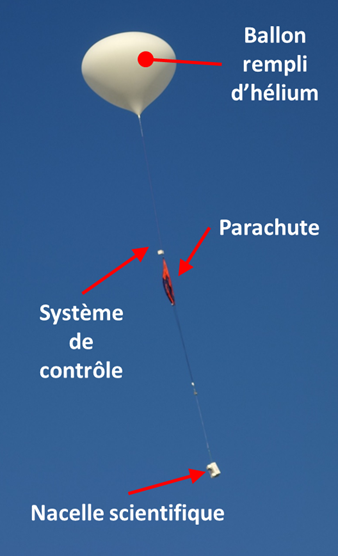NASA takes off from URCA.
In September, NASA arrives at the University of Reims Champagne-Ardenne (URCA), ready to embark on a new scientific adventure. In collaboration with the AEROLAB research and innovation hub of the GSMA (UMR CNRS 7331) mixed research unit, NASA is conducting an innovative measurement campaign. The goal: to study aerosol particles and greenhouse gases (GHGs) related to biomass fires and volcanic activity up to the stratosphere, using the unique atmospheric balloon launch site at URCA.
Aerosols, tiny suspended particles, can originate from natural sources such as volcanic eruptions and wildfires, influencing the climate by reflecting or absorbing sunlight. While it is well established that medium to large volcanic eruptions can affect the stratosphere for months or even years, the growing influence of wildfires on stratospheric aerosols and GHGs is an emerging research area. This issue is becoming increasingly crucial with the rise in wildfires, as seen in 2022, when over 780,000 hectares were burned in Europe according to EFFIS (European Forest Fire Information System). In this context, URCA and NASA have joined forces to increase observations in the stratosphere to better understand the impact of these phenomena on the climate.
Essential Research for the Climate
To understand the link between wildfires, volcanic eruptions, aerosol particles, and GHGs, measurements must be taken in a specific geographical and atmospheric area. Teams have already conducted various surveys around the world; in Reims, they will work to clarify these interactions. Understanding this link is essential to better grasp the impact of biomass fires and volcanic activity on the radiative balance and thus on climate disruption. The climate is a complex machine, and it is important to understand each cog.
More than twenty flights are planned, weather permitting, with balloons reaching dizzying altitudes of up to 30 km. This measurement campaign is the second of its kind. The first, conducted from November 2021 to January 2022, launched 17 balloons and resulted in a renowned scientific publication. [1]
To conduct this type of measurement, URCA has developed its own infrastructure for launching probe balloons since 2018.
A Unique Launch Site Open to Collaboration
URCA has one of the few sites in Europe that allows the launch of lightweight (<3kg) and medium-weight (<6kg) balloons. Additionally, AEROLAB has developed very special systems in collaboration with CNES: lightweight expandable "hovering" balloons. Unlike traditional balloons that ascend to an altitude of 30 km before bursting, "hovering" balloons allow for the selection and maintenance of a precise flight altitude. This enables them to fly longer and cover larger areas, offering valuable flexibility for scientists.
With over 200 launches to its credit, the URCA site is designed to welcome researchers from around the world, promoting international collaboration. Moreover, it is certified by ICOS due to its ground measurement tower and the COCOON measurement system, acronyms well known among specialists. Unique in its kind, this site is a true breeding ground for cutting-edge scientific research, allowing for the development of crucial knowledge about our atmosphere.
A Promising Campaign
The measurement campaign conducted by NASA and URCA represents a significant advancement in the study of aerosol particles and GHGs related to biomass fires and volcanic activity. Thanks to this international collaboration, precise data will be collected, allowing for a better understanding of the impact of these phenomena on the climate. The choice of this unique atmospheric balloon launch site at URCA, with its "hovering" balloons, demonstrates an exceptional infrastructure for conducting leading-edge research.
This exemplary work significantly contributes to our understanding of atmospheric interactions and perpetuates the spirit of openness to international collaboration at this unique site.
What is a Stratospheric Balloon or Meteorological Balloon?
A stratospheric balloon or meteorological balloon is a valuable tool for studying the atmosphere. They are the only carriers capable of reaching such high altitudes, far beyond what aircraft can achieve, thus allowing data collection in the stratosphere, a region of the atmosphere that is difficult to explore.
As illustrated in the photo, the flight chain consists of a latex balloon filled with helium, a control system (separation, GPS, satellite communication, etc.), a parachute for descent after balloon separation, and finally, the scientific payload that performs the measurements.
They are used for various applications, such as weather monitoring, studying climate phenomena, and scientific research.
[1] N. Dumelié and Coauthors, (2024). Toward Rapid Balloon Experiments for Sudden Aerosol Injection in the Stratosphere (REAS) by Volcanic Eruptions and Wildfires. Bulletin of the American Meteorological Society, 105(1), https://doi.org/10.1175/BAMS-D-22-0086.1
